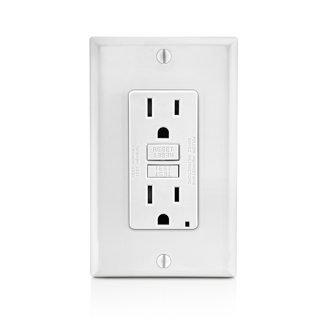 Have you ever wondered why GFCI outlet requirements exist? This article explains how National Electrical Code (NEC) regulations are in place so GFCIs can save lives.
Have you ever wondered why GFCI outlet requirements exist? This article explains how National Electrical Code (NEC) regulations are in place so GFCIs can save lives.
What are GFCIs?
Ground-fault circuit-interrupters (GFCI) are devices found on outlets, circuit breakers, extension cords and other electrical equipment. They detect imbalances in electrical current, quickly shutting off power to minimize the risk of shock and electrical fires.
In a home, for example, GFCIs constantly monitor electricity flowing in a circuit to sense any loss of current. If the current flowing through the circuit differs from what returns home (even if that current varies as little as 5 milliamps), the GFCI switches off power to that circuit in the blink of an eye – within 1/40th of a second.
There are three common GFCI types for home use:
- Receptacle: This is used in place of the average outlet found throughout an average house. It fits into a standard outlet box, protecting you from ground faults whenever something is plugged in.
- Circuit breaker: This GFCI type can be installed in a panel box to protect selected circuits. Not only will it shut off electricity in the event of a ground fault, but it will trip when a short circuit or overload occurs.
- Portable: If permanent GFCIs are not practical in a certain application, portable GFCIs are often a better option.
Where are GFCIs often used?
- Outdoors
- Garages
- Bathrooms
- Kitchens
- Sinks
- Crawl spaces
- Pools
These are places where moisture exists, and where electrical shock could be a factor.
Testing GFCIs
GFCIs should be tested after installation and once a month to make sure they’re working properly. For a test, plug a lamp into the outlet and press the “TEST” button on the GFCI. The GFCI’s “RESET” button should pop out, cutting power and causing the light to turn off.
If the “RESET” button doesn’t pop out, the GFCI is defective and should be replaced.
GFCI outlet requirements help save lives
NEC’s GFCI regulations are in place for a reason. When you mix electricity and water, you risk the following:
- Nerve and tissue damage
- Burns
- Gangrene
- Death
Additionally, GFCI’s could protect you from lawsuits. If someone gets shocked at your home, it’s possible they could sue. Older homes often don’t have these safety devices installed, and it’s estimated 200 people a year experience electrical shock as a result.
“While NEC is the leading authority on all things electrical, your local building authority has the final word on GFCI requirements,” NEC says on its website. “Check with your local building department for specific rules for installations in your area.”